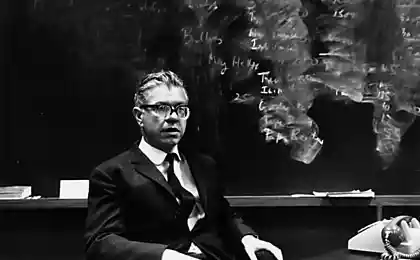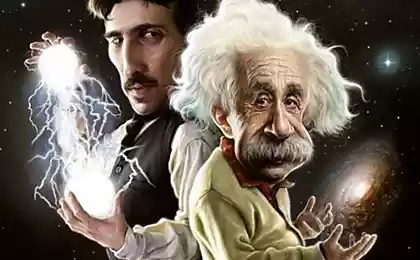484
The top 12 craziest scientific experiments
Science is fine if we are talking about laser beams or space missions, but some scientific experiments look like a complete madness:
Orgone energy
Psychoanalyst and follower of Sigmund Freud Wilhelm Reich invented an “orgone theory” in the 30 years of the twentieth century. He believed that orgone energy (life energy or the energy of space) is the basis of Freud's concept of libido and called it ergonomia. In 1940 he tried to accumulate orgone in the so-called "orgone accumulators" to use this energy to fight cancer. Not surprisingly, his dubious assumptions have not been confirmed, and he went to prison for attempting to smuggle abroad his "orgone devices".
Elephant addict inevitably
The study of the behavior of elephants resulted in the most cruel experiments in the name of science. Warren Thomas injected an elephant named Trucco 297 milligrams of LSD, which is 3 thousands times the dose that is able to withstand. The experiment conducted in Lincoln Park zoo in Oklahoma in 1962, was to determine whether it can cause temporary insanity have periodically experiencing bouts of aggression of males. An hour later Trucco died.
The two-headed dog
American physiologist Charles Guthrie has made a significant contribution to science and even collaborated with the French doctor Alexis Carrel, received the 1912 Nobel prize in physiology for his work on vascular surgery. Guthrie also was nominated for the award, but he refused, probably because experiments on transplantation. He sewed the dog a second head. Surprisingly, his experiments have even had some success: the severed heads could artificially to keep alive during the transplant.
Dog Frankenstein
Vladimir Demikhov – one scientist, obsessed with transplantation. It is widely known as the father of heart transplantation. As Charles Guthrie, Vladimir with varying degrees of success conducted his experiments on animals and in particular dogs.
Puncture with a mammoth
Korean vet, a researcher and Professor of theriogenology and biotechnology Huang Woo-Suk periodically made apparent breakthroughs in stem cell research and his discoveries published in the most renowned journals. However, all this was forgotten when he was accused of embezzlement and breach of bioethics. He spent more than half a million dollars of voluntary donations for unsuccessful attempts to clone a mammoth.
The doctor drinking the vomit of patients to prove non-infectious origin of the disease
American doctor Stubbins firs is famous for its research into the causes of yellow fever. He was so sure that this disease is non-communicable, that tested their own hypotheses on ourselves. His experiments included accommodation in the most dangerous for infection conditions to be sure to pick up a disease. Some of his conclusions later proved to be correct, but the explanation was no good. Shortly after his death, the Cuban scientist Carlos Finlay discovered the link with yellow fever insects.
The man is a cyborg
British scientist and Professor of Cybernetics, University of reading, UK Kevin Warwick is known for his research in the field of robotics. He also manages one of the world's most advanced cyborg research, and is the first cyborg in the history of mankind. Thanks to the electrodes and chips implanted into his body, he was able to control his robotic arms with power of thought.
Therapy against the habit of nail biting
A researcher from Virginia Lawrence Leshan conducted a test to see whether subliminal messaging to get rid of such harmful habits, such as nail biting. During the experiment, he was standing in the room where she was sleeping a group of boys, and many times repeated the words: "my fingernails are terribly bitter". He wanted to see whether he will be able thus to wean the boys biting his nails. It would seem that the experiment worked, because 40 percent of the investigated got rid of this habit, but at the same time, several issues have emerged, for example, do the boys sleep?
Homunculi
Paracelsus - physician and alchemist, who lived in the XV century. He is known for his early work in toxicology and psychotherapy. He was also the first who used the term "unconscious" in the clinical sense. However, the most whimsical his work is the creation of a homunculus (a miniature human). Presumably, to create the human egg is transplanted into the uterus of the horse, and that horse fed on human blood. Of course, no evidence of the success of such experiments no.
The revival of the dead
A child Prodigy from the University of California at Berkeley Robert E. Cornish received a diploma with honors at the age of 18, and at 22, he defended his doctoral thesis. He became interested in the idea of returning the dead to life. In 1930, Cornish tried to revive animal, namely, a few Fox Terriers. He rocked their bodies on the swing to simulate the circulation of blood and simultaneously injecting them with adrenaline and anticoagulants. Those animals, who still came back to life for a few moments, there was a blindness and brain damage, very quickly, they died again. But even this he could never repeat to a person.
The weight of souls
American doctor Duncan MacDougall in the early 20-ies put forward the theory that the soul has weight. He claimed that can measure the mass that is lost when the soul flies away. In his experiments he weighed six patients before and after death, and it turned out that the soul weighs 21 grams. Of course, its conclusion never received recognition in the scientific community.
Pierced his own heart
In 1929, German surgeon Werner Theodor Otto forssmann was still an Intern, but became famous thanks to the experiments, conducted on himself. Quite independently he injected a local anaesthetic through a vein in the arm fed the catheter in your heart. He did this without anyone's help. After this stunt he was fired. However, in 1956, forssmann was awarded the Nobel prize in medicine for discoveries related to cardiac catheterization.
source
Source: /users/147
Orgone energy
Psychoanalyst and follower of Sigmund Freud Wilhelm Reich invented an “orgone theory” in the 30 years of the twentieth century. He believed that orgone energy (life energy or the energy of space) is the basis of Freud's concept of libido and called it ergonomia. In 1940 he tried to accumulate orgone in the so-called "orgone accumulators" to use this energy to fight cancer. Not surprisingly, his dubious assumptions have not been confirmed, and he went to prison for attempting to smuggle abroad his "orgone devices".
Elephant addict inevitably
The study of the behavior of elephants resulted in the most cruel experiments in the name of science. Warren Thomas injected an elephant named Trucco 297 milligrams of LSD, which is 3 thousands times the dose that is able to withstand. The experiment conducted in Lincoln Park zoo in Oklahoma in 1962, was to determine whether it can cause temporary insanity have periodically experiencing bouts of aggression of males. An hour later Trucco died.
The two-headed dog
American physiologist Charles Guthrie has made a significant contribution to science and even collaborated with the French doctor Alexis Carrel, received the 1912 Nobel prize in physiology for his work on vascular surgery. Guthrie also was nominated for the award, but he refused, probably because experiments on transplantation. He sewed the dog a second head. Surprisingly, his experiments have even had some success: the severed heads could artificially to keep alive during the transplant.
Dog Frankenstein
Vladimir Demikhov – one scientist, obsessed with transplantation. It is widely known as the father of heart transplantation. As Charles Guthrie, Vladimir with varying degrees of success conducted his experiments on animals and in particular dogs.
Puncture with a mammoth
Korean vet, a researcher and Professor of theriogenology and biotechnology Huang Woo-Suk periodically made apparent breakthroughs in stem cell research and his discoveries published in the most renowned journals. However, all this was forgotten when he was accused of embezzlement and breach of bioethics. He spent more than half a million dollars of voluntary donations for unsuccessful attempts to clone a mammoth.
The doctor drinking the vomit of patients to prove non-infectious origin of the disease
American doctor Stubbins firs is famous for its research into the causes of yellow fever. He was so sure that this disease is non-communicable, that tested their own hypotheses on ourselves. His experiments included accommodation in the most dangerous for infection conditions to be sure to pick up a disease. Some of his conclusions later proved to be correct, but the explanation was no good. Shortly after his death, the Cuban scientist Carlos Finlay discovered the link with yellow fever insects.
The man is a cyborg
British scientist and Professor of Cybernetics, University of reading, UK Kevin Warwick is known for his research in the field of robotics. He also manages one of the world's most advanced cyborg research, and is the first cyborg in the history of mankind. Thanks to the electrodes and chips implanted into his body, he was able to control his robotic arms with power of thought.
Therapy against the habit of nail biting
A researcher from Virginia Lawrence Leshan conducted a test to see whether subliminal messaging to get rid of such harmful habits, such as nail biting. During the experiment, he was standing in the room where she was sleeping a group of boys, and many times repeated the words: "my fingernails are terribly bitter". He wanted to see whether he will be able thus to wean the boys biting his nails. It would seem that the experiment worked, because 40 percent of the investigated got rid of this habit, but at the same time, several issues have emerged, for example, do the boys sleep?
Homunculi
Paracelsus - physician and alchemist, who lived in the XV century. He is known for his early work in toxicology and psychotherapy. He was also the first who used the term "unconscious" in the clinical sense. However, the most whimsical his work is the creation of a homunculus (a miniature human). Presumably, to create the human egg is transplanted into the uterus of the horse, and that horse fed on human blood. Of course, no evidence of the success of such experiments no.
The revival of the dead
A child Prodigy from the University of California at Berkeley Robert E. Cornish received a diploma with honors at the age of 18, and at 22, he defended his doctoral thesis. He became interested in the idea of returning the dead to life. In 1930, Cornish tried to revive animal, namely, a few Fox Terriers. He rocked their bodies on the swing to simulate the circulation of blood and simultaneously injecting them with adrenaline and anticoagulants. Those animals, who still came back to life for a few moments, there was a blindness and brain damage, very quickly, they died again. But even this he could never repeat to a person.
The weight of souls
American doctor Duncan MacDougall in the early 20-ies put forward the theory that the soul has weight. He claimed that can measure the mass that is lost when the soul flies away. In his experiments he weighed six patients before and after death, and it turned out that the soul weighs 21 grams. Of course, its conclusion never received recognition in the scientific community.
Pierced his own heart
In 1929, German surgeon Werner Theodor Otto forssmann was still an Intern, but became famous thanks to the experiments, conducted on himself. Quite independently he injected a local anaesthetic through a vein in the arm fed the catheter in your heart. He did this without anyone's help. After this stunt he was fired. However, in 1956, forssmann was awarded the Nobel prize in medicine for discoveries related to cardiac catheterization.
source
Source: /users/147























